The Nile Delta Incident
The Egyptian menace...the Ottoman Empire has been dealing with those dogs for years. Now, after spies at the Covenant Embassy in Tehran learned of plans to arm the Egyptians with terrifying new energy weaponry, the fury of the Sultan has landed on them again.
Sultan Suleiman, may he live eternal, would prefer to end this danger surreptitiously. He would have his Jannisary forces secretly infiltrate the dock yards and sabotage these weapons. However, his spies have discovered the work is being done in hiding somewhere, out of the eyes of the Sultan. So instead he will prove the might of the grand empire by smashing the Egyptian economic engine and destroying their oil production in the shallow waters of the Nile Delta. Admiral Abdulhamid has mobilized his grand fleet. Unfortunately, such a movement of steel and sturginium does not go unnoticed. The Federated States of America has begun to shift its Mediterranean fleet out of port at Gibraltar in defense of its vulnerable friend. Federated States Admiral Leland P. McInerny has received orders to steam with all haste and all ships available to the southeastern corner of the Mediterranean. Washington has feared for some time the Ottomans would make a move like this; as a show of force to Istanbul and commitment to Cairo, the War Department has dispatched the dreadnought FSS Nathanael Greene to the Mediterranean Theater of Operations, and in a rare stroke of luck the massive vessel arrived in Gibraltar just in time to take on fresh supplies and move out with the rest of McInerny’s squadrons. Washington sees the Egyptians as an important element to its overall strategy of combatting the Bond, particularly by keeping the Ottomans occupied. The American fleet will defend the oil rigs and turn the advance of the outnumbered Ottoman fleet at all cost.
Importantly, the Ottomans are not without friends--granted they are poor friends not much better than brigands and pirates, but friends nonetheless. Reluctantly a message was dispatched to Capitaine Elmaleh la Corsaire of the 3rd Légion Navale de Corsaire. If he can harass the FSA fleet sufficiently from the islands around Crete and Lesbos the Ottomans may have a level playing field in the coming action. However, you never know what goes on inside the mind of a pirate turned military leader. Will he fulfill his duty or will blood lust and glory cause the attack to falter?--------
Forum member Quickdraw and I got together at Gamer's Haven in the Springs a few weeks ago to play a truly massive game of Dystopian Wars--2500 points per side. As noted above, Quickdraw was playing his Ottomans with support from the French, and I was playing my Federated States navy. We both had Labor Day off, so we met at the store early in order to get in as many turns as possible.
The initial board set-up looked like this:
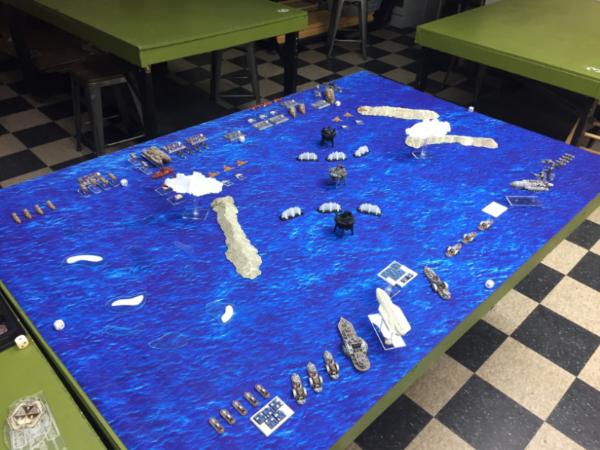
With 2500 points apiece, we opted to use Strategic Forces (flanks and reserves) so that not everything would be on the table at once. We both decided to move our Strategic Forces onto the board in turn three. (On a side note, I like that in version 2.5 you can choose when to bring in your reserves/flanks, instead of rolling randomly for their deployment).
The Ottoman/French battle line:
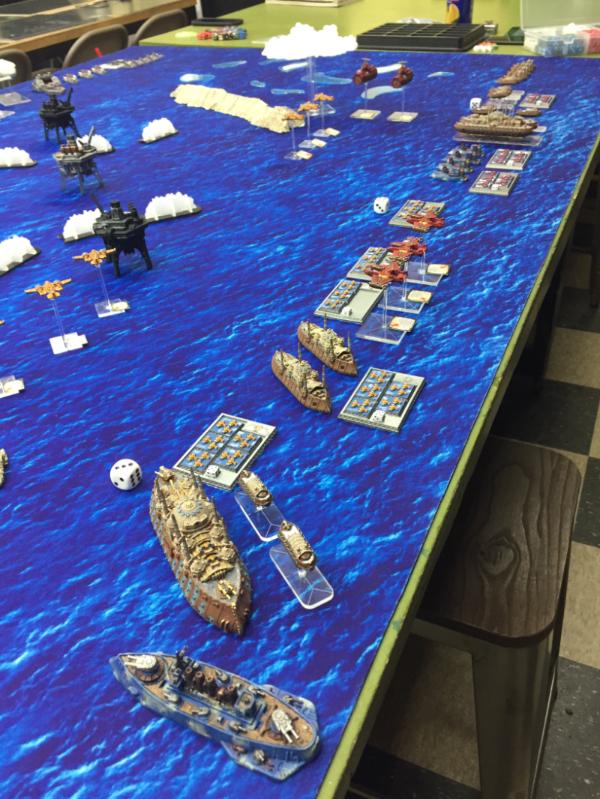
And the FSA battle line:
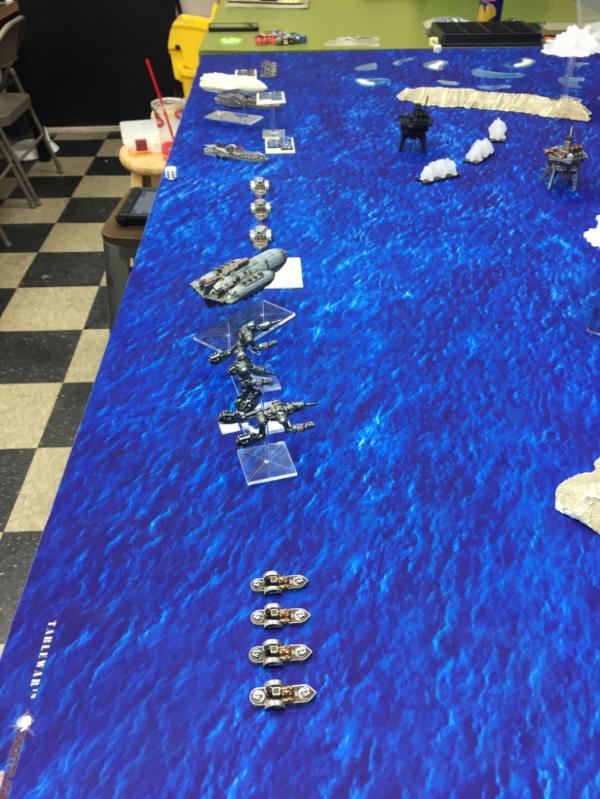
The oil rigs were lined up diagonally in the center, with some scattered terrain. We dropped markers in between the rigs to show that there was fog in the area--shooting through the fog resulted in a -1 for the "to hit" numbers. Each turn after turn one, we rolled a D6 to see if it burned off (had to roll the current turn number or lower). It stuck around for quite awhile!
As is usual with the Ottomans, Quickdraw spent most of turn one dropping mines from his Zhuhaf minelayers, and I spent an inordinate amount of attack dice shooting at them--partially because I didn't want him to drop more mines, and partially because they were about the only thing in range.
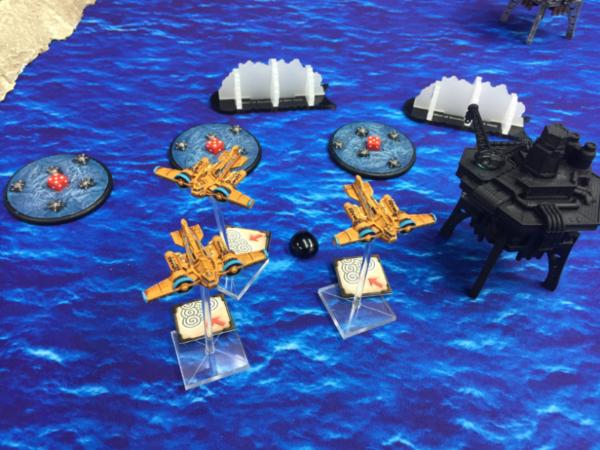
Those mines are a real pain, but at least they were nicely painted!
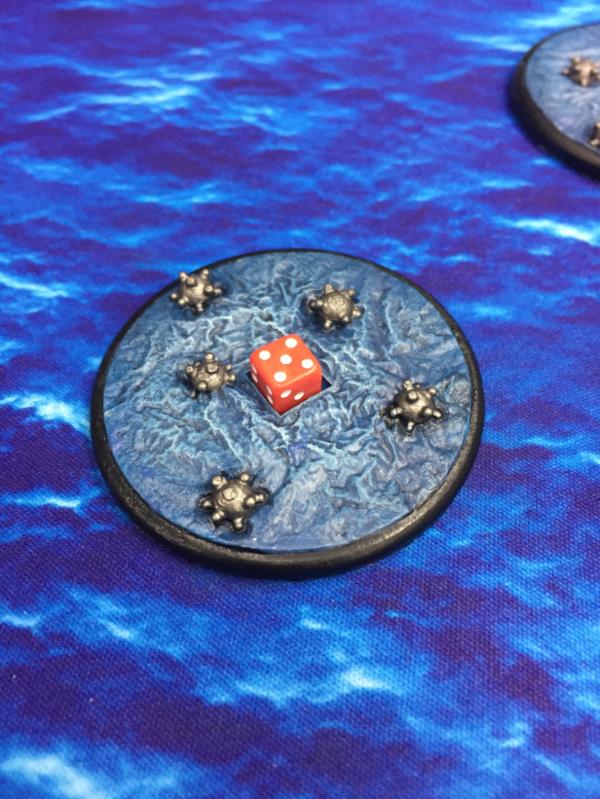
The Franco-Ottoman fleet was attempting to destroy the three rigs--this was achieved by conducting a successful boarding action. The house rules were that the rigs had no AA to fend off boarding assaults, and each rig had eight civilian workers on board--noncombatants, so they were only hitting on 6's in the defense against each boarding action. If the boarding was successful, the rig was considered "destroyed". The rigs did block line of sight for all ships due to their incredible size.
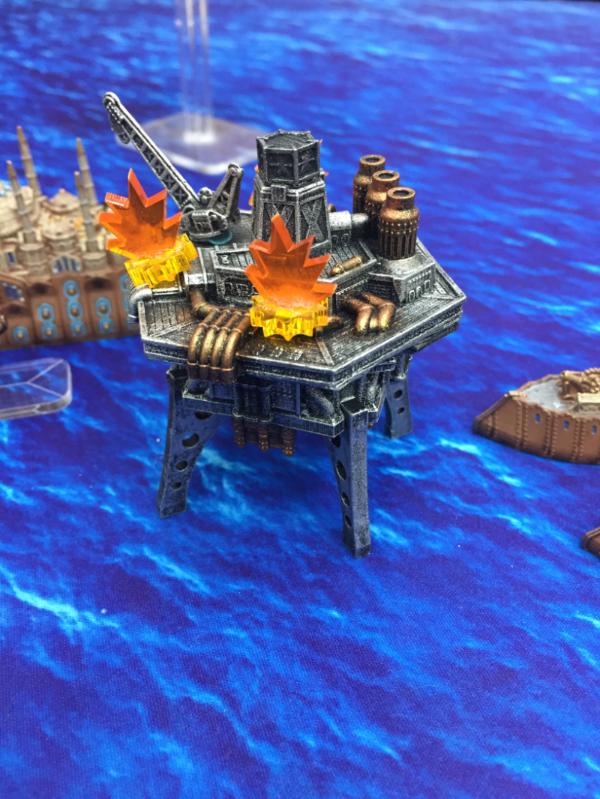
As it turned out, the Ottomans had destroyed all three rigs by the end of turn three. Quickdraw deployed some forces in his advanced zone, so they were much closer to the rigs than my ships were--in retrospect I should have put out some advanced squadrons as well.
After the rigs were destroyed, general combat continued across the board, with a few separate fierce battles erupting in the center and on both flanks.
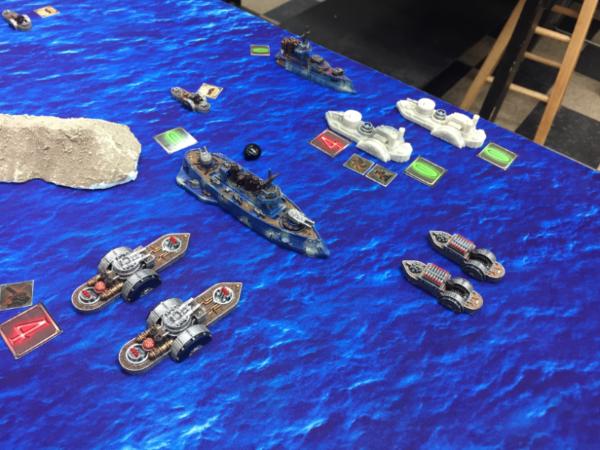
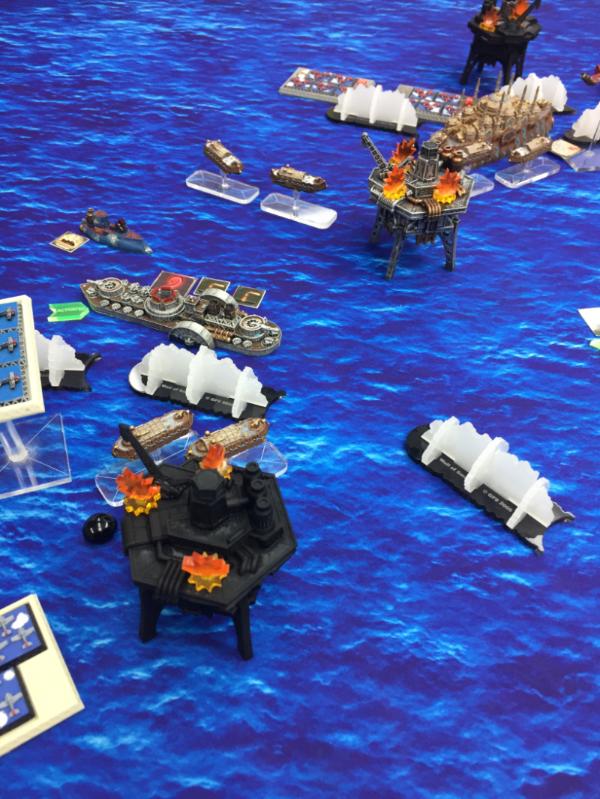
The state of the battlefield at the end of the game:
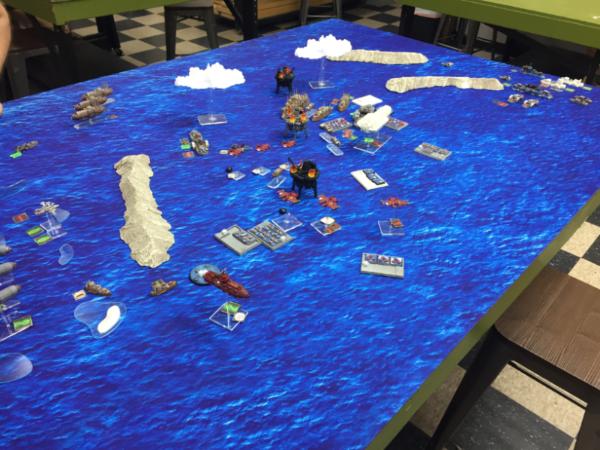
The Franco-Ottoman fleet was successful in destroying the oil rigs, and sank or captured over 2,000 points' worth of American ships. The FSA was unable to defend the rigs, and sank or captured about 1,600 points' worth of French and Ottoman vessels. It was a great game, and also nice not to have to keep glancing at the clock. I did learn one vital lesson, however--much like not getting involved in a land war in Asia, one must also not engage the Ottomans in an area-denial game, because they are very good at that tactic. Most of my gunnery for the first three turns was only hitting on 5's or higher, due to the fog banks and the Ottoman storm generators. I wasn't able to really get any clean shots until sometime in turn three. A bit frustrating to say the least!
Here are a few more pics:
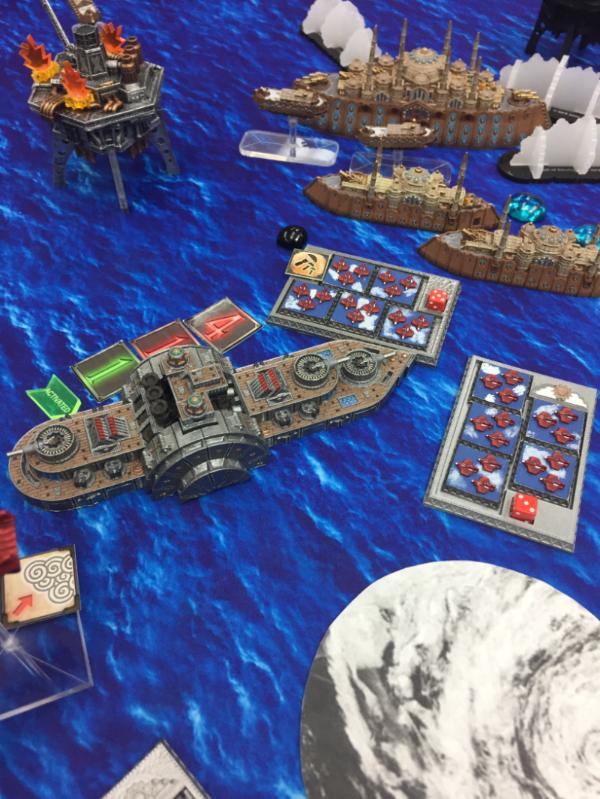
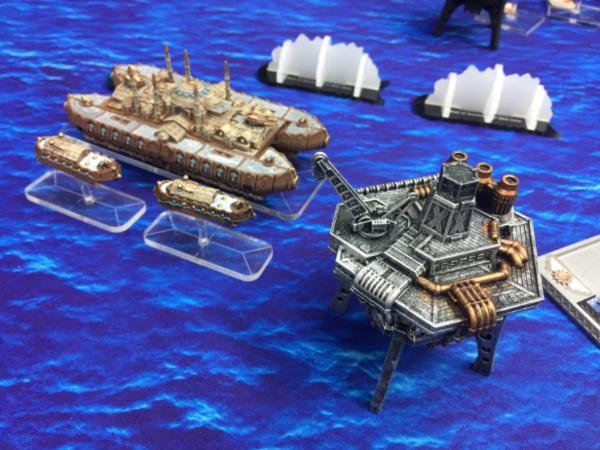
(no, the oil rigs aren't completely painted yet--working on it!)
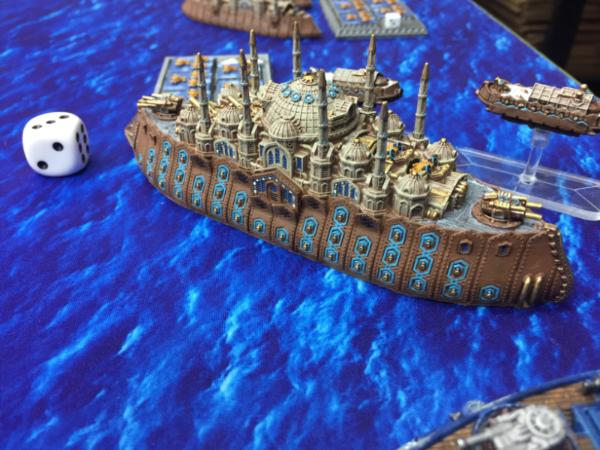
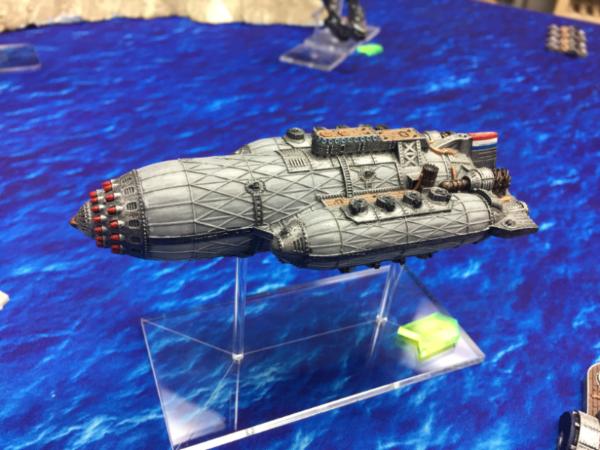
----------
Admiral Abdulhamid grinned with satisfaction as he watched the crippled FSA dreadnaught limp out towards open water in an attempt to escape. The Sultan would be pleased with the destruction of the Egyptian resource production, as well as the thrashing given to the Americans. However, the battle that followed after the objectives were claimed was a blow to the total power of the Grand Ottoman fleet.
More importantly Abdulhamid considered the capture of the French pirate Elmaleh. Surely the Americans would have a public trial and find him guilty of war crimes, most likely to be executed. While Abdulhamid did not find this disturbing--he was, after all, a brigand and a shadowy ally--the Sultan would surely take the diplomatic position and request he be saved. The Ottomans could not afford to offend a close friend as powerful as the Republique.
Aboard his flagship, Admiral McInerny pondered the day's fight and the mauling his fleet had received from the Ottomans. Several squadrons completely lost, and many others badly damaged--to include the dreadnaught! All was not lost, however. Young Lieutenant Franklin, the platoon leader of the marine contingent assigned to McInerny's gunship squadron, had daringly boarded the French battleship and captured the dreaded corsair Elmaleh.
McInerny knew this would make the central Mediterranean a safer place, at least for the time being, as the French forces would be in disarray after losing both their flagship and their captain.
But how would the Sultan react? McInerny knew that was the big question. He also knew it was above his paygrade to figure that out; he would fight, or not, based on what Fleet Command back in Washington decided.
McInerny knew that, for now, his most important mission was to get the remains of his fleet back into port, along with their unexpected French guest...I'm sure this isn't the last we'll hear about Abdulhamid, McInerny, and Elmaleh.
Thanks for reading!